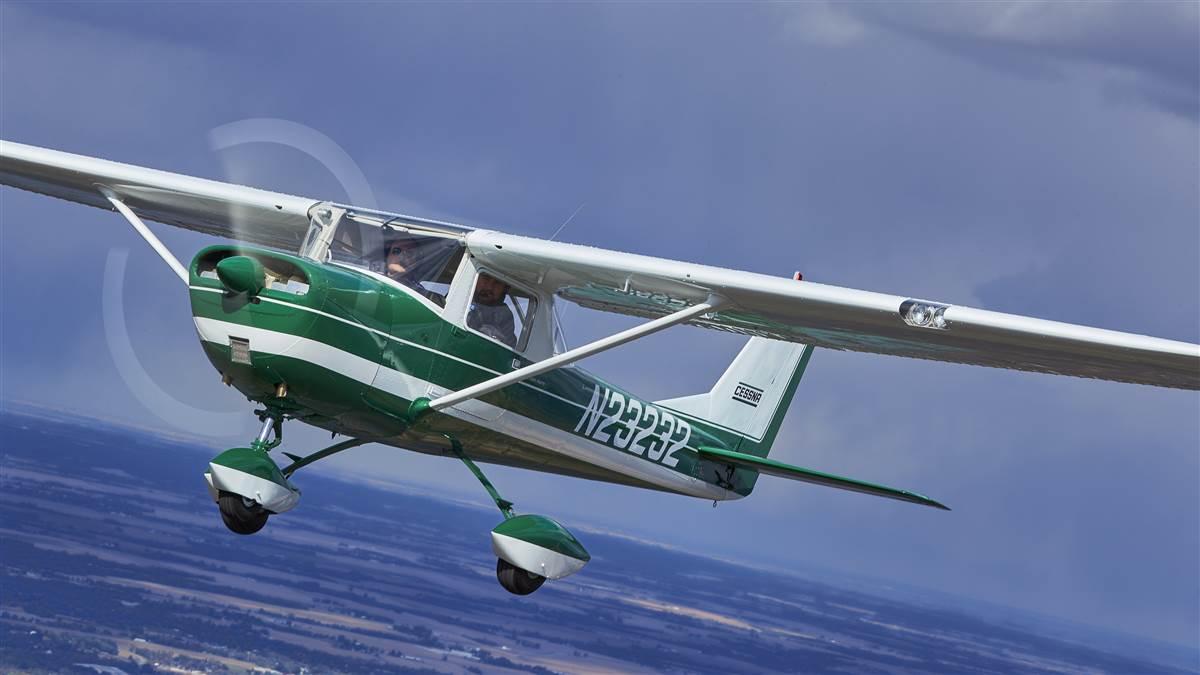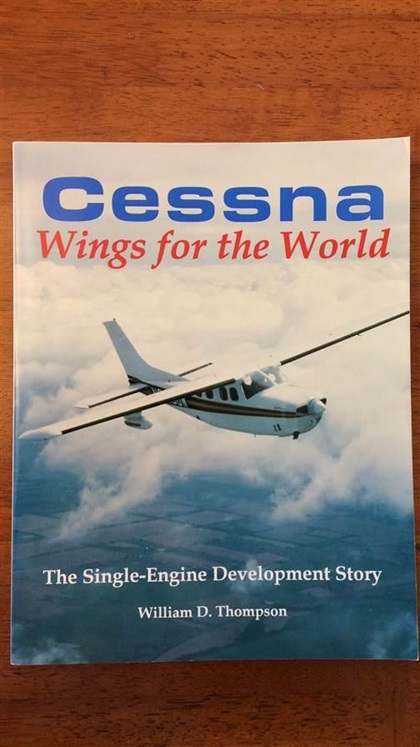Only new twice
A Cessna 150 is made factory fresh again

His remarkable restoration of the first production Cessna 172, its aluminum fuselage polished to a mirror finish, attracted throngs of admirers. Ozment won a Grand Champion-Gold Lindy for his effort (see “Flying Treasure,” sidebar).
Two years later, at AirVenture 2019, attendees strolling past the Fun and Affordable Corral in front of the Vintage Red Barn spied a 1968 Cessna 150 that appeared to have just rolled off the factory floor. Its dark-green-and-white paint perfect. Its interior so authentic, a young aviator exclaimed, “that is what a brand-new Cessna 150 must have looked like!” Another admirer mentioned the restoration was completed by the same person who brought the first production Cessna 172 to Oshkosh two years previously. Who would restore a Cessna 150 to perfection after restoring a historically significant Cessna 172?
a tale of two cessnas






Meet Dennis Ozment
Ozment lives in Quincy, Illinois, once a thriving transportation center on the banks of the Mississippi River. “My dad always loved aviation,” he said. “Growing up, my mom, when she would go to the store, she would bring home an airplane book. [Airplanes were] always surrounding me growing up, even though we didn’t have an airplane, there were no pilots in our family.” Ozment first flew an aircraft while in the Army. His training to become a flight medic required him to solo in a Bell UH–1 Huey. “I was the first person in the family to really fly. Then I got out [of the Army] and I was able to get my license in a 150.” Ozment inspired his father, brother, and uncle to earn pilot certificates.
“When you picked up your airplane brand new from the dealer in 1968 this is what it would have looked like and this is what we were going for.”—Dennis OzmentBy profession, Ozment is a rheumatologist (an “arthritis doctor,” he explains), but he has long been accumulating the skills needed to restore airplanes. “It’s just me and my mechanic Rodney Halfpap. We’ve worked together for years, we’re good friends. It works out to have a good friend who’s an IA. When it comes to annuals, I tear everything apart and he comes by and looks at it and says, ‘yeah, that looks good to me,’ and I put it all back together. He’s taught me a lot.…I had never done an owner-assisted annual till I had the 172.”
Ozment’s hangar at Quincy Regional-Baldwin Field (UIN)—where both aircraft were restored and painted—is decidedly not of the surgically clean variety. “This is our restoration shop,” said Ozment. “As you look around it’s a pretty junky shop. But it’s about the airplanes; it’s about making those the focus of things.”
Cessna 172




First love
Ozment’s decision to restore a Cessna 150 was based on his emotional attachment. “Growing up looking at Trade-A-Plane magazine, it was always Cessnas I was looking at, because it looked like something I could afford one day,” he said. “Historically, many of us as pilots started in a Cessna 150 and that’s the very first thing we ever flew—I learned to fly in a 150. And, you just see so many 150s that are sitting out on ramps and are not taken care of. To me I thought it would be nice to bring back something that was very special to all of us in aviation.”
Ozment found a candidate airplane that was completely original, had never been operated by a flight school, and had only 1,800 hours on the tach. “When I saw the pictures on Barnstormers of the 150—that green and white—I said, ‘that’s it.’ I just knew immediately that that was going to be the one. I kind of look at it as, it’s 1,800 hours, it’s TBO. I thought let’s do the whole airplane. Let’s not just overhaul the engine, which we did right here in the shop. So, we did a full restoration nose to tail.”
Original is the mantra
Ozment purchased a 1968 Cessna 150 sales brochure on eBay, which became a critical source of information to determine factory paint schemes, seat fabric colors and stitching, and instrumentation. It also helped him determine what on his Cessna 150 was not original. “Everything in here is Cessna,” said Ozment. “There’s no reproduction parts anywhere on the airplane. All the plastic is either original to the airplane or new old stock from different sources. Just trying to find parts…is part of the fun of doing these aircraft restorations. Using your different sources to be able to find these parts that are literally 50 years old or older.”
The control yokes were reconditioned and powder coated by SairCorp/Flight Boss Ltd. “The yokes are held on by semi-tubular steel rivets. You can still get those rivets from Cessna, but they’re very expensive. If you screw it up, that’s a $70 rivet. Times four,” said Ozment. Air Mod reupholstered the seats, comparing vinyl they had to samples in the brochure. The carpeting was sourced from Airtex Products. Ozment installed new windows, using rivets instead of screws to secure the window hold-down strips, as Cessna had done in the factory. He even found a rare hat shelf for the baggage compartment, which was a factory option.
An example of Ozment’s painstaking attention to detail involved the lettering embossed into the plastic of the lower instrument panel. He painted the panel with SEM plastic paint and then used the tiniest brush he could find to fill in each embossed letter with Testors white model paint.
After two big projects, Ozment could probably add a doctorate in aviation restoration to his résumé. “Every piece on the airplane was touched,” he said. “When you picked up your airplane brand new from the dealer in 1968 this is what it would have looked like and this is what we were going for.”
Cessna 150










The result
After the restoration was complete in 2019, Ozment made a beeline for Oshkosh—an annual pilgrimage he’s made with his dad for more than a decade. “There no question about whether we’re going or not, it’s just what we do,” he said.
Surely, he believed he might have a chance of winning another Gold Lindy. “We were doing a restoration to do the restoration. There was never a goal of winning at Oshkosh. We were going to do it right. We weren’t going to take it for granted. There’s lots of nice airplanes that show up there.”
“The theme for [AirVenture] 2019 was ‘fun and affordable’,” said Halfpap, “so the 150 fit right into that. It’s an introductory aircraft, too, as far as learning to fly it doesn’t get any better than a 150. They’re affordable; they’re cheap to operate; insurance is reasonable.”
Ozment added, “It just so happens that the thing that I like, which is originality, is the thing that they like up there, too. They’re all about originality and I am too, so it works out pretty good.” The judges at AirVenture appreciated the Cessna’s faithfulness to the original enough to present Ozment a Grand Champion-Gold Lindy, his second in three years.
Cessna 150 Zen
Ozment’s happy place is in the cockpit of his Cessna 150. “It’s not an overly taxing airplane,” he said, “you’re not worried about landing gear coming up and down. It’s just an airplane to go fly. And it’s about flying, it’s not about going somewhere, it’s about flying.” He flies each of his immaculate Cessnas for about 45 minutes every weekend the weather cooperates. It’s his opportunity to get away and enjoy time in the sky alone.
Halfpap, who ran a paint shop on the field and restored many aircraft, said, “This is a lot more fun, it really is. [With other customers] we start on an aircraft that basically needs restoration, go through the entire process, and once you’re done with the airplane the customer would take the airplane and fly away. Well, that’s the end of it for me. But with Dennis it’s totally different because now we’ve not only completed the aircraft, we get to take it and show it and be part of that process, as well. In the end it’s been very rewarding as opposed to just getting a check cut to you for your efforts. This way you see it all the way through to the end, and you also get to fly it.”
“That’s right,” said Ozment, “Rodney has the keys to everything and has free reign to do whatever.
“I love this airplane,” said Ozment. “It brings joy to me because it’s a nice fun airplane that at the end of the day, despite all of the stresses you’ve had, all the problems you’ve had to deal with, you can come fly this airplane and just enjoy life.”
Email [email protected]

 Those interested in the origins of the Cessna 150, Cessna 172, and all other single-engine Cessnas should read Cessna, Wings for the World: The Single-Engine Development Story. In the soft-cover book, retired Cessna engineering test pilot William D. Thompson reveals the trials, tribulations, and successes achieved during his tenure helping to develop many of America’s best-selling general aviation aircraft—from the 1946 Cessna 140 to the 1984 Cessna Grand Caravan. Told from an engineer’s perspective, Thompson’s stories get a bit technical—but are terrific for Cessna nerds, like me. Available for $25 plus shipping and handling at
Those interested in the origins of the Cessna 150, Cessna 172, and all other single-engine Cessnas should read Cessna, Wings for the World: The Single-Engine Development Story. In the soft-cover book, retired Cessna engineering test pilot William D. Thompson reveals the trials, tribulations, and successes achieved during his tenure helping to develop many of America’s best-selling general aviation aircraft—from the 1946 Cessna 140 to the 1984 Cessna Grand Caravan. Told from an engineer’s perspective, Thompson’s stories get a bit technical—but are terrific for Cessna nerds, like me. Available for $25 plus shipping and handling at 

